CLEANLINESS IN JAPAN
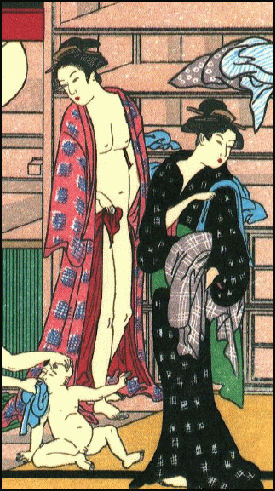
Cleanliness is perhaps more important to the Japanese than with any other culture. The Japanese use the same word (“kirei”) for "clean" and "beautiful” and purification is an important element of all Shinto rituals. When Japanese pray for something important they wash their bodies and dress in a white kimono. Sumo wrestlers throw salt to purify the ring and Japanese taxi drivers wear white gloves to indicate the immaculate state of their taxi. When schoolboys want to hurl out the worst insult they can think of, they call someone a "bacteria."
In Buddhism cleanliness is associated with morality. In Shintoism it is associated with purity. By contrast in Greco-Roman and Western tradition cleaning was a manual task left to the lower classes.
Unusual Japanese products with a cleanliness theme include hair spray that purports to removes sweat and cigarette odor, pills that claim to remove the bad smell from bodily wastes and special hygienic foods for pets.
Despite the efforts that Japanese make towards keeping their bodies clean, they same energy does not go into their homes. Many Japanese homes are cluttered and messy, and have stuff sprawled all over the floors.
Websites and Resources
Bathing Customs Rituals and Etiquette at Japanese Public Bath Fabulous Travel ; Bathing Etiquette sentoguide.info ; Japan Visitor Japan Visitor ; Japanese Design on Baths japanesehomeandbath.com ; Links in this Website: BEAUTY, HAIR STYLES AND COSMETICS IN JAPAN Factsanddetails.com/Japan ; MALE BEAUTY, TATTOOS AND COSMETICS FOR MEN IN JAPAN Factsanddetails.com/Japan ; BATHING IN JAPAN Factsanddetails.com/Japan ; HYGIENE AND CLEAN FREAKS IN JAPAN Factsanddetails.com/Japan
Onsens in Japan: Book: “A Guide to Japanese Hot Springs” by Anne Hotta (Kodansha, 1986) and “Japan's Hidden Hot Springs” by Robert Neff (Tuttle, 1986). Websites: Good Bath Photos at Japan-Photo Archive japan-photo.de ; Good Onsen List with Pictures Japanese Guesthouse Onsen Guide Hot Springs Michelin ; Japan Spa Association Spa.org ;Onsen Express onsenexpress.com ; Secret Japan secret-japan.com
Mixed Sex Baths Onsen Map with Mixed Sex baths Secret Onsen ; Sukayu Spa (near Aomori) is famous for its 1,000-person mixed-sex cedar bath where both men and women bath naked together. Websites: Secret Japan ; Onsen Express Onsen Express . Kuroneiwaburo is a public open air mixed sex bath with stunning ocean views in Higashi-Izucho, Shizuoka Prefecture about an hour and half from Tokyo . In 2008 it welcomed about 30,000 male bathers and 17,000 females. Website: bousui.com/hotsprings bousui.com/hotsprings/
Black Sand Beach Baths Sand Bath site Hakusikan Ibusuki City site Ibusuki City Frommers Frommers.com Map : Ibusuki Iwasaki Hotel ibusuki.iwasakihotels.com Beppu: Beppu City official site Beppu City Beppu Tourism Association Welcome to Beppu ; Map: Beppu City official site Beppu City Info Mao Japan Info Map Japan ; Beppu Tourism Association Welcome to Beppu ; Hot Springs Around Tokyo include Kamata Onsen (Kamata station on the Keihin Line); Soshigaya Onsen (Soshigaya Okura station on the Odakyu Line); Azuba Juban Onsen (Azabu Juban station on the Nanboku and Oedo Line); and Seta Onsen (Futako Tamagawa station on the Tokyu Denen Toshi Line). Most of these are not true hot springs in that they draw up water from cold springs and artificially heat it. Most have saunas and a variety of therapeutic baths. Websites: Secret Japan secret-japan.com ; Sunny Pages sunnypages.jp ; Kusatsu Onsen Kusatsu Onsen site kusatsu-onsen.ne.jp
Japanese Bath Etiquette
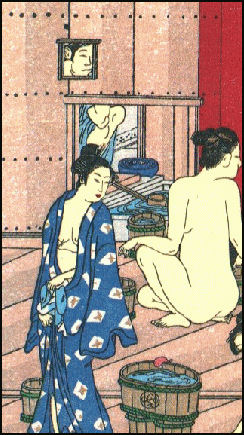
According to Japanese bathing etiquette one must wash with soap before stepping in a bath, and wearing a bathing suit, towel or underwear in a bath is considered crass an unsanitray unless one is in a mixed sex bath that requires bathers to wear them.
Before entering a bath, bathers usually sit on small stools, rinse with hand-held showers and wash with small towels which are squeezed dry. In the shower is a small plastic basin. It is customary to site on the stool and use the hand-held shower to fill the basin with water and dump the water on yourself. Japanese often wash each other's back and the back's of strangers in the public bath.
People staying at an onsen often wear a yukata (robe) between their room and the bath. Don't wear jewelry in the bath because the metal may tarnish or be altered by the chemically-rich water. Foreigners should be prepared to be stared at. It is not unusual for all the occupants of a bath to leave if a less-than-meticulously clean foreigner enters the bath. Heavily-tattooed people are not allowed into Japanese onsens because of their association with the yakuza. In the men’s bath there are sometimes girls up to late elementary-school age running around and elderly women wokers in bathroom and locker area.
Japanese often carry a towel with them into a public bath and place it on their head or private parts. Women sometimes wrap the towels turban-style around their heads. Some onsens don’t want you to bring the towel in the bath. Some men men like to place them flat on their head. These wet small towels are also used to dry off. Sentos and onsens generally supply customers with towels, Some charge a fee of ¥100 to ¥200. At home Japanese sleep with dry towels in the summer and wash with wet ones.
In the old days it was common for men to have a smoke while relaxing and watching a baseball game after a good soak in a public bath. But these days smoking is generally not allowed as the baths try to attract a more health conscious clientele. The trend is more common in Tokyo than Osaka, where many baths still allow smoking.
Bathing in Japan
Bathing is a common form of relaxation for Japanese. Some Japanese take two or three stoking hot baths a day and many like to spend holidays and weekends traveling to spas and hot springs. According to a study Japanese take a bath an average of five times a week in the summer and six times a week in the winter. Even though 70 percent of households have showers, 80 percent of Japanese insist they prefer a hot bath to a shower. Immersion in water is said to cleanse the body of worldly sins and bestow sevenfold luck.
One 35-year-old female office worker told the Japan Times, "For me taking a bath is an indispensable part of my daily routine, just like cleaning my teeth after a meal. I can never be satisfied with a shower. A bath feels much better."
Muchihiko Ueda, a Japanese doctor who has written extensively about bathing, told the Japan Times that a shower just heats up the surface of he body while a long, soaking bath warms up the entire body. "The blood circulation speeds up and more oxygen is carried to the internal organs," he said. "Therefore, metabolism is enhanced...Also by soaking in a bath you can recover from physical fatigue more quickly, because muscles get soft and lactic acid that builds up through exertion is removed more promptly. Moreover, the floating feeling in the water greatly aids relaxation."
Baths have traditionally been a place where people socialized. The Japanese expression “hadaka no tsukiai” (frank companionship, or literally “naked socializing”) is used in descriptions of bath taking.
“ Thermae Romae “ by Mari Yamazaki is manga about a Roman architect who specialized is designing pubic baths who is transported to a bathhouse in modern Japan where he finds all sorts of cool things. “ Thermae Romae “ is Latin for “Roman baths.”
Japanese baths come with a number of items: plastic bowls used to douse the user with water; plastic bath covers that keep the water warm for along time; and a shampoo shields, which keeps shampoos out of children’s eyes.
Home Bathing in Japan
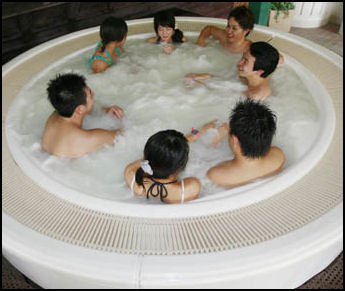
soy milk bathJapanese generally like to bath in water between 38̊ to 42̊C. Most Westerners bath in water between 33̊ to 36̊C and find Japanese baths to be scalding hot. Many Japanese have heaters and thermostats that keep the water at temperature that the user likes. Some also have bathrooms outfit with waterproof televisions and boom boxes.
Traditionally, the family bathtub was filled with hot water and individuals washed themselves of with soap before entering the bath or sat outside the bath on a stool and dipped water from the bath onto themselves. Often several family members bath together or bath one after another in the same water, which is sometimes left in the tub for several days to conserve water. For families with young children, it is often the father’s responsibility to bath with children after dinner before they go to bed.
Some Japanese don’t like custom of sharing the same water. One 17-year-old girl who refused to enter the water used by her father told the Los Angeles Times, "My dad sweats a lot. He wants to go in first, but I say I'm going first, so he just gives up."
Bath paraphernalia includes soap, shampoos, a stool, washbasin, not water scooper, bathtub cover, bathtub stirrer, and thermometer. Inflatable bath rings for babies were used among parents who wanted to leave infants unattended while they did chores until reports appeared in the media of the death from drowning of a 10-month-old girl and near death 10-month boy now in vegetative state after the rings they were in overturned.
Many Japanese like to put mandarin orange peels in their baths. The sale of bathing salts and scents is big business. Popular aromas include coffee, ginger, and hot peppers. Cucumber extract is believed to have a cooling effect. Egg and honey are regarded as beautifying agents.
As for washing one’s hands before a meal Japanese tend to use cold water while Americans use hot water.
Japanese Public Baths
In the old days, many homes didn't have bathtubs or showers, so people bathed at public bath houses (“sentos”), which were a fixture many neighborhoods and places where people gathered and socialized. Some of the larger ones were decorated with large paintings above the tubs, often depicting Mt. Fuji or some other mountain scenery to create a sense of spaciousness.
Many Japanese take three or for long soaks interspersed with cool showers or breaks outside the bath. The water in a Japanese public bath is typically around 101̊F to 105̊F, hot but not scalding. Many Japanese baths have special filter systems to keep the water clean.
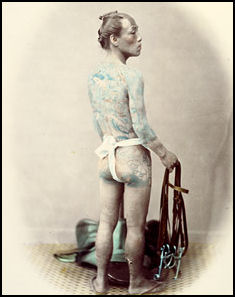
19th century public bath employee The first public bathhouses opened in early 17th century. Male customers often played board games, ate sweets and had their backs washed by women called “yuna” while sitting in the bath. The back washing led to prostitution and brothel-bathhouses were banned in 1657 but continued to exist.
These days most people bath at home and and public bath houses have largely disappeared. The number of bath houses in Japan has declined from 23,016 at the peak of their popularity in 1964, when around 93 percent of the population regularly went to baths, to 8,422 in 1999, when 93 percent bathed at home and didn’t go to public baths. There are even fewer today.
In an effort to remain afloat, bath houses in urban areas are trying to attract joggers and bike riders who can’t shower at work. Some public baths in Tokyo have begun offering magic shows for the naked bathers and Internet access with waterproof PCs.
An inn in Yugawara in Kanagawa Prefecture allows dog and ferret owners to take bath with their pets. Cat are generally not allowed because they are afraid of water. The fees are between $10 and $20 for half hour bath. The bath is cleaned after each appointment.
Onsens, Japanese Hot Springs
An “onsen” is hot spring spa that is sought during a vacation or weekend trip as a place to escape and relax. Japan has 19,445 thermal resorts and spas, known as onsens, scattered across the country and they welcomed about 130 million people a year. There used to be more. In 2002, there were 22,127 of them. Many of them offer mineral baths, health activities and massages. Unlike European spas people generally don't drink the water but bath in it (but some places do encourage visitors to drink it to). Many offer accommodation and meals.
Hot springs have long been thought to have healing powers, There are stories of samurai bathing themselves after battles and farmers seeking them to cure their cuts and sore muscles, In the 19th century one the main goals of some early train lines was to make hot springs more accessible to the cities.
There are two kinds of baths: “notenburo” (“indoor baths”) and “totemburo” (“outdoor baths”). Tere are also baths only for men (“otoko-yu”), only for women (“omna-yu” and mixed gender ones (“konyoku”). The Japanese have an expression for the social boding that takes place in a bath: “hadaka no tsukiai” (“naked companionship”).
Most onsens have several baths that can vary a lot in size. Most of them very hot water, with maybe one with exceptionably hot water and another with cold water. The latter is often only big enough for one or two people. Some baths alternate the men’s and women’s section on a weekly, daily or even hourly basis.
In the old days, men and women went nude in the mixed sex baths. That is no longer the case. Most of onsens have segregated indoor and outdoor baths for men and women. Some have a large outdoor bath (rotenburo) where men and women can bath together in bathing suits or with a towel wrapped around them. But as a rule swimsuits are considered unsanitary. For more on mixed bathing see below.
Onsen Offerings
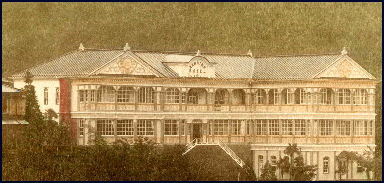
19th century hotel Onsens offer a variety of baths and bathing experiences: individual, communal, inside, outside, mixed or single sex baths, cold baths, hot pools surrounded by trees and rocks, warm water swimming pools, black sand baths, mud baths, baths of graded temperatures, mineral baths, waterfalls, walking pools, cold pools, jacuzis, steam rooms, swimming pools with water slides, outdoor pool with bars, baths scented with small floating bags of citron and orange peel, and herbal baths.
Some onsens have baths that contain salt imported from the Dead Sea, allowing bathers to bob and float as of they were in the Dead Sea. Others have radioactive water with radon that is supposed to improve your health. Contradicting what many people think, one study in Japan found people who lived around a hot spring with high levels of radiation have lower cancer rates than the general population. Some go to great length to get their water. Some of Tokyo’s 144 hot spring wells pump from depths up to 1,700 meters underground
Some baths have mineral waters that purportedly treat a host of illnesses. Some of the baths have clear water. Some have a reddish tint. Others are grayish. Each bath is said have curing powers for a different ailment. These baths often have the mineral content listed and the ailments that each mineral treats. Some of the nicest onsens have huge painting in the dressing rooms and feature cypress wood baths that give off a pleasing aroma when filed with hot water.
Many hot springs add tap water to their baths. Some use more tap water than hot spring water. According to the government regulations hot spring water can be diluted with tap water if the water is too hot or contains high levels of chemicals or minerals. There are no set standards for how much tap water can be added because the mineral content of the springs sometimes vary with the season.
Some places have saunas. In November 2008, people from 57 countries took a sauna together at Ritsuneikan Asia Pacific University in Oita Prefecture to break the record for people from the most different countries taking a sauna at one time. The previous record of 50 was set in Niigata Prefecture in 2007.
Onsen Accommodation
Onsens usually offer accommodation and meals. Ends to themselves they usually have several baths and are popular weekend trip destinations, particularly for women. Many resemble large hotels and have indoor baths. Other are more like country inns and have indoor and outdoor bathing facilities. Some baths are reached only after taking a hike through the mountains.
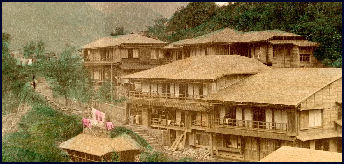
19th century ryokan Some are quite luxurious: filled with artworks and an army unIformed employees relentlessly saying "excuse me" and "thank you" for this and that. Prices range from $70 to $500 per person per night, including a large dinner and small breakfast. Day trippers who don't spend the night are charged between $5 and $10.
The room are often simple Japanese-style room with tatami mats and a low table and futons that are unfurled at night. The meals are set and offered at a specific time. Often times onsens meals are served in the guest's room. They often contain a variety of vegetable, pickle and fish dishes, served artistically in small amounts.
Many onsens have transfer service from the trains stations. This is usually in the form a small van that picks up guest outside the station and take them to the mountains where the onsen is located. Once guest arrive they shed their clothes and put on bathrobe-like yukatas and are given towels. Many onsens in the mountains have hiking trails around the facility. Guests squeeze in hikes between meals and baths. Many are open late into the night and allow guest to drink sake while they are taking a soak.
Mixed Sex Bathing in Japan
Mixed sex bathing was the norm in the 19th century. The first European arrivals were shocked by the custom. At that time they believed that bathing was harmful to health. Missionaries who tried to convince new Christian converts to stop bathing had little success. Mixed sex bathing endured to the 1950s, when female legislators in the Diet insisted on laws that segregated the sexes at private baths.
The majority of spas and public baths in Japan today have separate baths for men and women. But not all of them. The Sukayu Spa (near Aomori) is famous for its 1,000-person coed cedar bath where both men and women bath naked together. People who are shy about their bodies can hide their private parts with a towel but the majority of people are naked and they seem more interested in enjoying the soothing water than looking at the naked bodies around them. Sukaya has permission from the government to be coed.
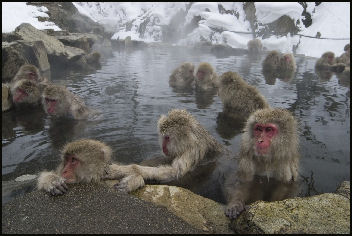
All prefectures prohibit mixed-sex nude bathing among participants that are not related. But the rules vary. Of Japan’s 47 prefectures 35 allow “family bathing.” Among these, Fukuoka Prefectures allows “couples to use their facilities.” Kagawa Prefecture states family baths are “not for the unspecified majority, and those exempt from the mixed-sex category.” Twelve prefectures do not allow family bathing.
“Private bathing” was introduced in the mid 1990s and is offered by many onsens. Under its terms, groups can rent out of “private bath” much as they do a private dining room in a restaurant. The baths are intended to be used for family baths but sometimes they are used groups of adults or people who claim to be family members but in reality are not.
In some other places mixed baths are making a come back and they get a surprising number of women. Kuroneiwaburo — a public open air mixed sex bath with stunning ocean views in Higashi-Izucho, Shizuoka Prefecture — is not far from Tokyo and is one of the largest mixed sex baths in Japan. In 2008 it welcomed about 30,000 male bathers and 17,000 females.
In any case, cleaning women going about their chores and little girls with their fathers are common sights among the naked men in men's dressing rooms in gyms, public swimming pools and public baths. A New York Times reporter recounted one episode in which an American wearing his underwear was told to remove it by a woman worker before he stepped into the bath. The reason for this was that the cleaning women had a job to do (keeping the dressing room clean) and she had to go about her duties even if it meant telling a man she didn't know to expose his private parts.
Views on Mixed Sex Bathing
Mixed sex bath has become increasingly popular with young women, A 29-year-old female company employee told the Yomiuri Shimbun, “I can’t bathe with my boyfriend at an ordinary hot spring. At first I felt embarrassed to enter a mixed bath, but now I don’t mind as long as my boyfriend is with me.”
Akiko Yoshinaga wrote in the Yomiuri Shimbun, “I tried mixed bathing for the first time at Kuroneiwaburo. I wrapped a towel around my body, but at first I was so timid I could not take the next step. However, I did eventually manage to enter the bath, and once in, I gradually began to relax and not worry about whether people were looking at me. In fact, I found I really enjoyed talking to the other bathers — maybe I too could get hooked on mixed bathing.”
Mayumi Yamazaki, author of a book about mixed sex bathing, told the Yomiuri Shimbun, “I think women have far more curiosity [about mixed sex bathing] than men. And it seems today’s young women don’t mind exposing their bodies to strangers.”
Some women though complain they are ogled by men. Sukayu, a large mixed sex bath in Aomori Prefecture post signs that read: “Bather’s should not oogle bathers of the opposite sex” and “Don’t look, don’t show.”
Some women bathers complain about “alligator men” — men who hang out at the baths for hours and move about with their heads barely above the water towards female bathers like an alligator stalking prey.
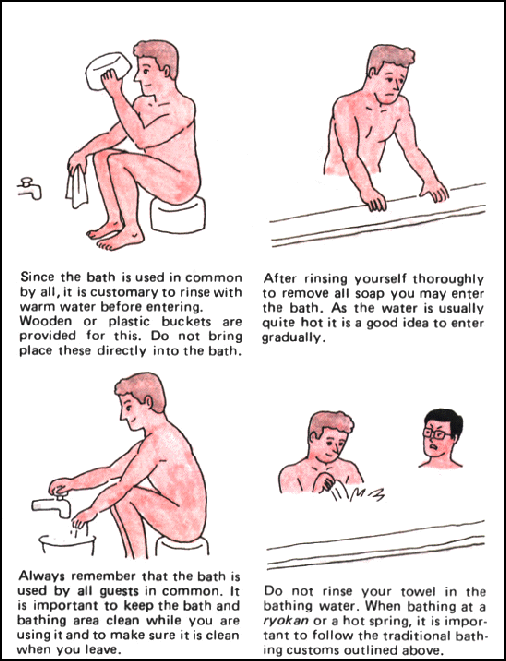
Researchers Study Whether Dogs Like Hot Springs
In January 2012, the Yomiuri Shimbun reported: “Are hot-spring baths as relaxing for dogs as they are for humans? A research team from a professional training college in Okayama City is looking into the matter. Dogs unaccustomed to bathing in hot springs do exhibit signs of stress, but appear to relax again as they become more familiar with the activity. [Source: Yomiuri Shimbun, January 8, 2012]
Okayama University of Science Specialized Training College, a vocational training school for animal health technicians, conducted the study at Yubara hot spring in the city of Maniwa, Okayama Prefecture, from May 2010 to October 2011 with help from the Maniwa City government and an association of inns and hotels in the former Yubaracho area, now in Maniwa. The group intends to study better ways for dogs to bathe in hot springs.
The study group placed seven dogs, including border collies, in a dog-only hot spring facility for 15 minutes to measure changes in body temperature and amylase concentrations in their saliva. Amylase, a digestive enzyme, was used as a barometer to gauge stress. They found that the dogs' body temperatures rose by 0.2 C while bathing in the hot spring, and that their bodies would retain heat for one hour after bathing. When the dogs were in the bath, amylase concentrations increased to about twice their pre-bathing levels, but returned to normal levels 15 minutes later.But once the dogs got out of the hot spring, amylase concentrations were triple that of normal levels, returning to normal after 50 minutes.
The research team believes the levels first rose because the dogs were bewildered by a new environment, dropping once the dogs became familiarized and relaxed. The team also believes the dog's stress levels increased after bathing due to the noisy hair driers researchers used to dry the dogs. Naoko Minami, an animal health technician and an employee at the vocational training school, said, "We still can't explain clearly the effect of hot spring water on dogs, but [we can say that] it's best to bathe dogs in a hot spring at times when they feel less stressed." Minami advised bathing dogs in hot springs after a 30-minute rest period, as a lengthy car drive to a spring can be burdensome for dogs.
Onsen Troubles
A study found that even though most onsens claim to be natural hot springs, 70 percent use water that is pumped up from underground. Only 30 percent were real hot springs in which natural water bumbles to the surface. So much water is in being pumped from underground there are worries it may dry up hot spring water supplies.
In one survey a third of the onsens admitted they diluted the hot spring water with tap water. Half said they recycled water through filters and 40 percent failed to respond. Other studies and research have uncovered onsens that had water trucked in from other places, or ran it over mineral ores so it could be labeled as mineral water. Others have dangerous bacteria. At one Onsens in Miyazaki Prefecture, 295 bathers became ill and seven died from a mass legionella infection caused by contaminated water.
In 2003, it was revealed that one onsen famed for its milky-white water added a powder to the water to give it the milky color. Further investigation found that several other onsens used similar tactics to give their water unique colors or characteristics. In some cases the onsens originally had uniquely colored water but after supplies began running low additives were added out of fear that tourist would no longer come. In recent years an effort has been to regulate the onsen industry so that onsen live up to their claims. Some that has added tap water ir run misleading ads have been criminally charged.
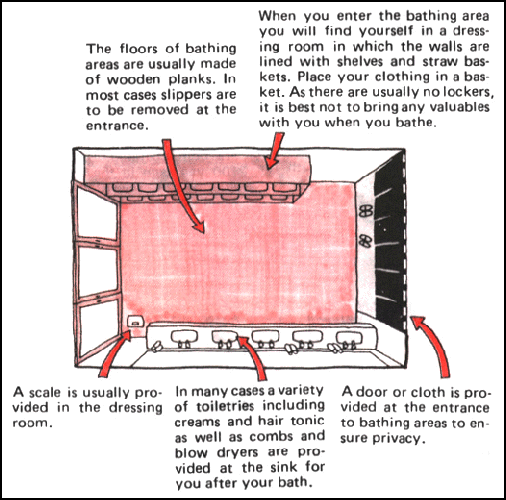
Revelations of water tampering have hurt an industry that was already in a state of decline. Some people with reservations have called and demanded their money back. Onsens that didn’t tamper with their water have been hurt as much as those that did. A couple onsens were shut down after police raids. Onsens are currently closing at a rate of 100 a year.
Spa and Onsen Accidents in Japan
In June 2007, a large explosion at the Shiesa spa facility in Shibuya ward in downtown Tokyo killed three spa employees and injuring eight other people. The blast, caused by the ignition of natural methane gas, blew off the roof and obliterated the building that housed the spa and seriously damaged other building in he neighborhood.
The explosion was blamed on a faulty design of the gas separation system and the failure to install methane detectors and air inlet ducts, thus allowing natural gas from spring water to collect in the basement of the spa, where machines pumped water from a source 1,500 meters underground and separated methane from the water. The spark or heat that ignited the gas is believed to have come from a water pump. The spa and contractors that built the gas separation system were found guilty of negligence.
Three employees of a construction company and an operator at the spa were charged with negligence. The construction company employees failed to notify the operators of problems with the systems and the operator failed to take adequate safety measure such as installing a gas detector for the facility.
In a freak accident in December 2005 all four members of a family were killed by hydrogen sulfide gas outside a hot spring in Yazawa, Akita Prefecture. Two boys in the family were playing frisbee and one them fell into a two-meter wide, 1.5-meter-deep sinkhole that had filled with the poisonous gas, which had been emitted from the hot spring and sunk and collected in the sink hole. When the boy’s brother arrived to help he too was overcome by the gas. The same fate occurred the father and mother. The father managed to drag one of the boys out of the hole before he was overcome by the gas and died. The boy died in a hospital the next day.
Enzyme Baths and Other Unusual Hygiene Practices
Some Japanese women enjoy taking "enzyme baths," in which they envelope their bodies in wood chips heated by fermented “Bacillus subtitles”. The Japanese also use enzymes to measure the alcohol content of wine and the freshness of sushi, and place enzymes in hospital toilets to monitor the health of patients by measuring the minerals in their urine. [Source: Thomas Canby, National Geographic, August 1993]
Women at the Nishiarai Kouse Sauna Center in Tokyo used to don paper bikinis and pay $20 to bask in 13 tons and $10,000 worth of coffee grounds for 30 minutes. Purported to cure a variety of ailments, the coffee grounds were in a pool-size tub and were heated to 140̊F through pineapple-juice-induced fermentation. [Source: Ethel Starbird, National Geographic, March 1981]
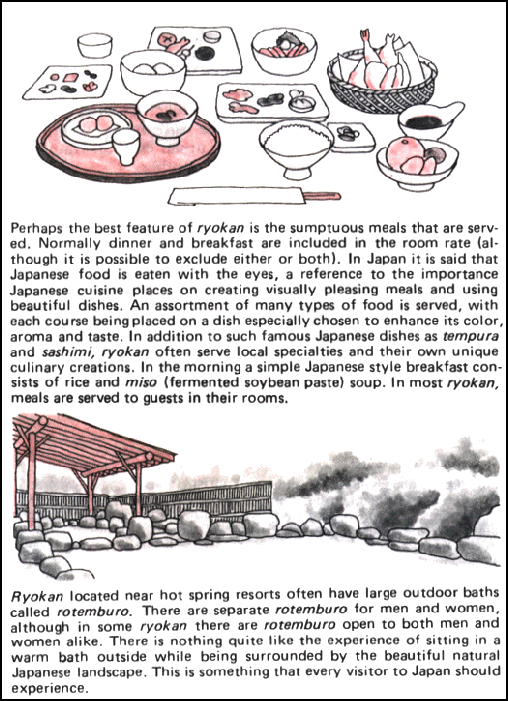
Ryokan onsen
In the winter some Japanese men dress in loincloths and douse themselves in freezing cold water or stand under frigid waterfalls. At Sukayu Hot Spring men kneel under streams of highly acidic mineral water which they believe will cure their aching joints and muscles.
Some baths have green water that deliver a slight electric shock when you get in the bath. Some beauty salons offer fat-reducing seaweed cream treatments, and sweating treatments with Darth-Vader-like masks.
Black Sand Baths in Japan
Ibusuki — 30 miles south of Kagoshima on the southernmost tip of Honshu — is famous for its natural hot sand baths which can be taken right on the beach. The hot black sand is heated by natural steam and water from hot water springs passing through the sand. Ibusuki is the only place in the world where you can enjoy this unique experience. Altogether a 16-mile stretch of beach is heated by subterranean volcanic activity.
People have been taking the baths for more than 300 years. On person in the 19th century described them as “curing all kinds of illnesses and especially good for muscles and bones.” In the last hundred years it has been commonly used by farmers in the off season. Westerners first became aware of Ibusuki when it was featured in a Life magazine article in the 1960s. One facility today welcomes 270,000 to 300,000 visitors a year, with 80 percent of them coming from outside Kagoshima. These days more and more are coming from South Korea, China and Taiwan.
Describing his experience at a bath facility called Saraku, Shoicho Nasu wrote in the Daily Yomiuri, “I simply went to front desk and paid a ¥900 bathing charge and was issued a special yukata to wear in the sand bath. In the changing room, I stripped of all my clothes and put on a yukata, went outside the building and wandered along the beach. There I saw a simple structure offering a kind of roof over the natural sand baths. Up to about 100 people can lie under the the roof.”
“I lay down as instructed by one of the staff. The staff member, who happened to be a woman, poured sand all over my body with a shovel. All except m head that is. As she chatted about the tremendous beneficial affects of the sand bath, a man laying behind me joined our conversation. Saying that he came to this place regularly and never needed any doctors or medicines.
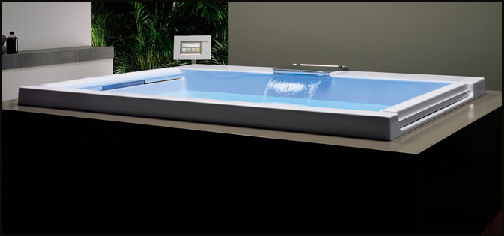
“Although the woman told me that most people lie down for about 10 minutes in the sand, I did so for half an hour. It felt so good with the pressure of the sand all over my body. But I did find that some time after lying down I began to sweat profusely, from my brow especially. To tell the truth. I was able to hold on for as long as I did only by keeping one thing in mind: the thought of a refreshing glass of draft beer...and the beer I had after washing off all the sand in the bathing area next to the changing room certainly did taste good.”
Image Sources: 1) 2) Torii Kiyonaga women bath 3), 6) 7) JNTO 4) Toto 5) Visualizing Culture, MIT Education 7) xorsyst blog
Text Sources: New York Times, Washington Post, Los Angeles Times, Daily Yomiuri, Times of London, Japan National Tourist Organization (JNTO), National Geographic, The New Yorker, Time, Newsweek, Reuters, AP, Lonely Planet Guides, Compton’s Encyclopedia and various books and other publications.
Last updated January 2013
